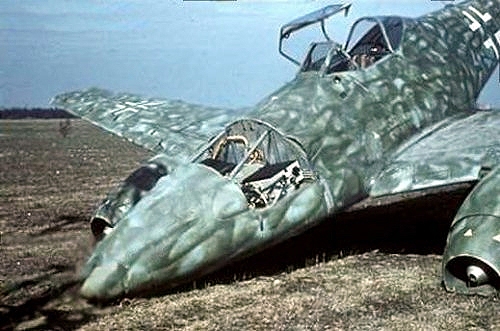Slave to the Game
Online Gaming Community
ALL WORLD WARS
THE DEFEAT OF THE GERMAN AIR FORCE
The United States Strategic Bombing Survey
This report was written primarily for the use of the US Strategic Bombing Survey in the preparation of further reports of a more comprehensive nature. Any conclusions or opinions expressed in this report must be considered as limited to the specific material covered and as subject to further interpretation in the light of further studies conducted by the Survey.
This edition has been reproduced by a photolithographic offset process from the first edition of the report. To expedite, standardize and clarify the printing of this and other European reports, minor changes have been made on the cover, title page and some drawings.
USSBS Series Foreword
The United States Strategic Bombing Survey was established by the Secretary of War on 3 November 1944, pursuant to a directive from the late President Roosevelt.
The officers of the Survey were:
Franklin D'Olier, Chairman.
Henry C. Alexander, Vice-Chairman.
George W. Ball,
Harry 1. Bowman,
John K. Galbraith,
Rensis Likert,
Prank A. McNamee, Jr.,
Paul H. Nitze,
Eobert P. Russell,
Fred Searls, Jr.,
Theodore P. Wright, Directors.
Charles C. Cabot, Secretary.
The Table of Organization provided for 300 civilians, 350 officers and 500 enlisted men. The Survey operated from headquarters in London and established forward headquarters and regional headquarters in Germany immediately following the advance of the Allied armies.
It made a close examination and inspection of several hundred German plants, cities and areas, amassed volumes of statistical and documentary material, including top German government documents; and conducted interviews and interrogations of thousands of Germans, including virtually all of the surviving political and military leaders. Germany was scoured for its war records which were found
sometimes, but rarely, in places where they ought to have been; sometimes in safe-deposit vaults, often in private houses, in barns, in caves; on one occasion, in a hen house and, on two occasions, in coffins. Targets in Russian-held territory were not available to the Survey.
Some two hundred detailed reports were made. During the course of its work, the Survey rendered interim reports and submitted studies and suggestions in connection with the air operations against Japan.
While the European War was going on, it was necessary, in many cases, to follow closely behind the front; otherwise, vital records might have been irretrievably lost. Survey personnel suffered several casualties, including four killed.
The Survey studied the effects of the air attack on Japan and further reports have been submitted to the Secretary of War and the Secretary of the Navy.
THE DEFEAT OF THE GERMAN AIR FORCE
FOREWORD
1. On 6 June 1944, General Eisenhower was able to say, "If you see fighter aircraft over you, they will be ours." This remark signalized the achievement of the first objective of the Allied Air Forces In Europe: the reduction of the GAF as an effective deterrent to land or air invasion. This attainment of superiority over the GAF, given priority in the Casablanca Directive of January 1943, was the result of concentrated air action during the nine months prior to D-Day by the Allied Air Forces In the European Theater. It was brought about primarily through
a. Attrition of the enemy fighter force in the air and on the ground, and the consequent deterioration of the quality of enemy fighter pilots;
b. Attacks on enemy aircraft production which caused vital delay in the expansion of the GAF fighter force.
The air superiority gained before D-Day was maintained throughout 1944 and 1945 by the combined efforts of the RAF and USAAF through attrition and
c. Destruction of the sources of enemy aircraft fuel production
d. Disruption of the GAF system for supply and repair caused by attacks on the German transportation system.
ATTRITION OF THE ENEMY FIGHTER FORCE
1. The GAF fighter army was a major obstacle opposing the Allied strategic air offensive. Its history is marked with periods of temporary successes which were turned to eventual defeat by the effective measures of the Allies. When the full onslaught of the Allied offensive was felt, the GAF could not mount a defense in the strength for which it planned and worked so desperately. This was partly due to faulty decisions in the early years of the war which contributed to the deterioration of the GAF when faced with a major opponent. It was primarily due to the aggressiveness of the Eighth and Fifteenth AFs in the. air battles fought during the attacks on German aircraft production. A review of the record of the years 1939 - 1944 brings this into focus. As a guide to this review, a chart is furnished (Figure 1) showing the comparative losses of the German fighter force over these years.
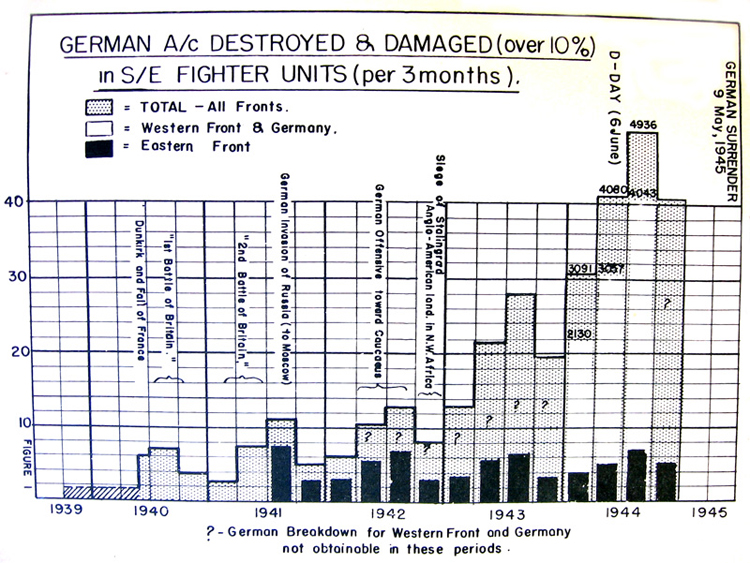
German A/C destroyed & damaged in S/E fighter units
2. It will be noted that the tempo of the air war, expressed in losses of German single-engine fighters[1], increased moderately through 1942, spurted ahead in 1943, and sky-rocketed in 1944. It is apparent also that the war on the Eastern Front involved a fairly steady attrition of the German single-engine fighter force which was never so excessive as to become a source of alarm to the German High Command. Hi is Is revealed in German aircraft production plans for the years 1941 and 1942 (Figure 2) when fighter losses on the Eastern Front constituted a high percentage of the total German losses. These plans called for virtually no increase in production until the daylight strategic bomber threat began to be appreciated in the latter half of 1942. At this time, the German Air Ministry In a study dated 16 December 1942, called for a tripling of fighter production in 1943 (Figure 2). With mounting losses in the air and on the ground, successive studies demanded further increases in production. These were not accomplished in time to cope with the greater expansion of the Allied air forces.
[1]Note: Similar figures for pilots killed are not yet available; the few facts now in hand indicate that between 2-1/2 and 3 aircraft were destroyed per pilot killed.
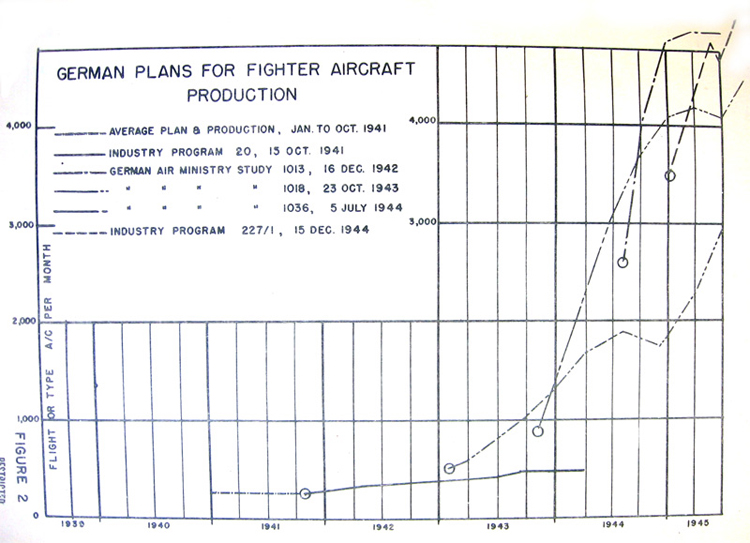
German plans for fighter aircraft production
3. Reduction of GAF Fighter Experience Level. The cycle which underlay the deterioration of the OAF worked in this manner: When more pilots were killed In 1942 than the Gorman High Command has anticipated, pressure was put upon the fighter training schools to speed the output of replacements. But Germany's fuel situation, Inherently weak, required careful allocation of all oil products, especially aviation gasoline. Increased fuel allocation for pilot training was very difficult for the schools to obtain. The alternatives were either to fall short of the number of replacements or to cut hours of training so that fuel allocations would be sufficient to train the requisite number of pilots. The Germans chose the latter course, with the result that replacements arrived at combat units subnormally trained (Reference Note 1). As skilled and experienced pilots we're killed, they were replaced with pilots with no battle experience and insufficient training. Thus, the average level of experience fell, reducing the tactical capabilities of the force. The rising tempo of combat worked cumulatively against the OAF. On the other hand, combat seasoned many Allied pilots who were fighting on a solid back¬ground of thorough training at less than expected rates of attrition.
4. The deterioration of pilot quality was first really apparent about March 1944. The cycle had undoubtedly been operating all through 1943, since the first large cut in total training hours of German pilots came late in 1942, followed by a similar cut in mid-1943, and much greater cut in mid-1944 (Figure 3). The last reduction in training hours of German pilots came at a time when oil targets in Germany were given first priority fop Allied strategic bombing. Then the inadequate allocations of fuel which the fighter schools had received could no longer be delivered. The early decision to skimp on gasoline allocations to training schools was turned painfully against the GAF planners who were now unable to ward off the attacks on oil. This was doubly painful because it occurred at a time when German fighter production was increasing.
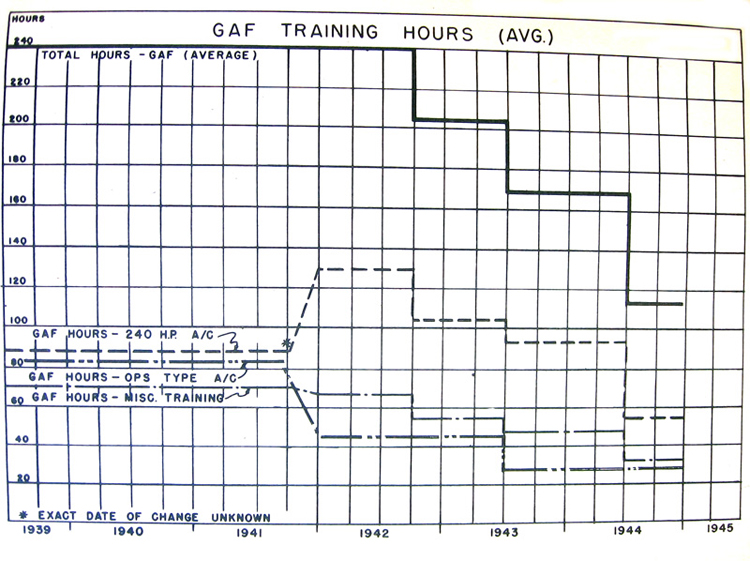
GAF training hours
The GAF situation was recognized by General Fieldmarschall Hugo von Sperrle who stated that the Luftwaffe was most seriously handicapped by a dearth of experienced pilots. This became extremely patent early In 1944. In July of 1944 he canvassed his command and found that, with rare exceptions, only group and squadron commanders had combat experience exceeding six months. A small percentage of other personnel had an average of three months of combat duty, while a majority of pilots had seen active service for periods as low as between eight and thirty days. In the autumn of 1944, disorganization and deterioration of the Luftwaffe began. Lack of fuel, shortages of pilots and a decreasing number of replacements hampered efficiency (Reference Note 2).
5. Rise of ITS Fighter Power. Critical losses of German fighter pilots were indirectly caused by the overpowering pressure applied by the USAAF on daylight missions. This pressure was carried deeper into enemy territory as a result of a series of Improvements In US fighter aircraft and their tactical exploitation. These are listed chronologically because of their great importance.
a. May 1943. P-47s arrived In Britain and Joined British Spitfires in escorting the heavy bombers. As US pilots gained experience in the handling of their aircraft and In air warfare, the P-47 pilots extended the range of their penetrations beyond that to which the Spitfires could go. Because of increased escort range, the bombers made somewhat deeper penetrations with the result that air fights increased in Intensity - the P-47's giving an excellent account of themselves.
b. July 1943. Belly tanks of 75-gallon capacity became available, adding more than 100 miles to the range of the P-47s, whose effective strength now had reached the £00 mark. The use of the tanks gave the P-47s tactical surprise over the enemy for a few missions, resulting in an increase In the number of kills. The enemy's twin-engine rocket fighter, so deadly to Allied bombers, was no match for the P-47 and learned early to stay beyond its range.
c. August 1943. One hundred and eight gallon belly tanks became available. This gave the P-47 a further extension in range, with the result that, after reaching the point where the enemy's twin-engine fighters had expected them to turn back, the P-47s attacked and shot them down instead enemy lose rates rose.
d. September 1943. Three groups of P-38s of the NW Africa Air Force made a low-level strafing attack on the enemy airfields near Foggia, Italy. The attack was a complete surprise; a great many enemy aircraft were destroyed on the ground and only a few rose to give combat. The success of this attack marked a turning point in the air war in the Mediterranean; thereafter losses of Allied bombers to enemy aircraft declined to a marked degree.
e. November 1943. P-38s with two 165-gallon wing tanks became available for escort in the Eighth AF and although mechanical difficulties marred their utility, their range was great enough to reach well into Germany. With the increase in bomber penetrations into Germany, the enemy attacked savagely, and the escort had all the targets it could desire. German losses continued to rise.
f. Mid-December 1943. F-51s now made their appearance in England. Their range without external tanks was nearly as great as the P-38 with the two 165-gallon wing tanks. Their four 50-calibre machine guns gave formidable firepower and flight characteristics were excellent (Reference Note 3). Early successes were so great that an increase in the number of P-51s was eagerly awaited.
g. December 1943. The newly activated Fifteenth AF was established in the Foggia and Manduria areas in southern Italy. This move increased the capabilities of penetration of US bombers and fighters, bringing within range many vital German and Balkan targets which could not be reached from North Africa. Fifteenth AF fighters included F-38s and P-47s using 75-gallon belly tanks.
h. January 1944. At this juncture, a change in the tactical employment of US fighters took place which was more far-reaching in its effects than any of the increases in range. Up to this point, because of the limited number of escort fighters available, they had operated under the strict Injunction that their duty was to "protect the bombers." This method of employment resulted in flying relatively close to the bombers in order to block enemy attacks. It placed US fighters in a defensive position, leaving the initiative to the enemy. US pilots spent all their time "looking over their shoulder. With the increased strength of fighter escort, tactics were changed to more fully exploit the characteristics of fighter aircraft. The fighters were now charged with the primary duty of "pursuing and destroying the enemy." Although a third of the escort remained in constant final defense of the bombers, the rest ranged out from the bomber formations, watching for the appearance of hostile aircraft. Upon sighting the enemy, this "ranging escort" would attack and pursue him wherever he fled. The enemy soon lost the initiative. He was hunted and harassed wherever he flew. Enemy losses began to rise sharply. Lieutenant General Karl Koller, Chief of Staff of the Luftwaffe, stated in this connection that the American long-range fighter cover came as something new and fatal to Germany. Without this cover, Koller had hoped to be able to inflict losses as high as 30 per cent upon un-escorted bombers which, in his opinion, would have made the continuation of the attacks impossible. He laid considerable stress on the fact that neither the British nor the Germans thought of fighters except in terms of the last war and of narrow ranges associated with land warfare in Europe. The German aircraft industry had claimed that an effective long-range fighter could not be built (Reference Note 4).
i. 30 January 1944. The Fifteenth AF carried out a counter air force mission in the Po River Valley with important consequences. While the bombers attacked airfields and aircraft repair depots from high level, the escort formed an "umbrella" which held down most of the Axis fighters, resulting in serious losses to the Germans on the ground. Those enemy fighters which were able to rise in interception were engaged by the US escort and many were destroyed. Air opposition in Italy to strategic day missions virtually ceased after this date.
j. February 1944. In this month 150-gallon belly tanks became available for the F-47s based in England, extending their range another 50 miles, and later in the month, two 108-gallon external tanks were fitted to the wings of the F-47s, adding still another 50 miles of range. P-38s received an addition of 60 gallons internally, extending their range of effective escort beyond Berlin; P-51s became available in somewhat greater numbers. The result of all this increase in Allied fighter capabilities was the dispatch, in the fourth week of February, of a series of missions against the German fighter aircraft factories as deep into Germany as Leipzig. During this phase of transition from evasion of the enemy to forcing the battle, the task forces of US bombers and fighters became bolder and more provocative. Actually, a month later, the Allied day bombers began to fly selected routes to force the GAF to fight. Enemy fighter loss rates, in planes and pilots, mounted rapidly, and replacement difficulties multiplied at a time when Allied air power was being increased and reinforced.
k. March 1944. During this month, more P-5ls and P-38s became operational in the Eighth AF and the F-51S began to carry external wing tanks. With two 75-gallon wing tanks, the P-51 could escort far beyond Berlin and even Prague. With two 108-gallon external wing tanks, escort, if desired, could be flown beyond Vienna. Flying with an increased number of these long-range fighters as escorts, the heavy bombers initiated a series of attacks on Berlin.
The air fights mounted in number and intensity. On one of these missions the bombers lost their largest number - 69. However this was only the ninth most serious loss of the Eighth AF in percentage of bombers attacking and it resulted in overwhelming the German ability to resist in the air. On the third mission, enemy resistance had declined and at the end of the series enemy fighters failed to put in an appearance. Heavy losses in planes destroyed and damaged had weakened the GAF operational ability to such an extent that it could not sustain the air fighting on a continuing basis even over German territory.
l. April 1944. The Fifteenth AF converted its P-47 group to F-51s and received additional groups of P-51s. Its fighter force then consisted entirely of P-51s and P-38s. The P-51s had sufficient range to permit escort to targets as deep as Brux in German-held Sudetenland and Blechhammer in a German Silesia. The P-38s were used for additional fighter support during both penetrations and withdrawals.
m. May 1944. Enemy loss rates mounted rapidly on the Western Front while US bomber and fighter losses declined at the same rate. Enemy opposition to the bomber raids had grown very little numerically in the last nine months. The number of bombers in US task forces had multiplied by four in the same period, and fighter escort numbers also had become four times as great (Figure 4). For example, in the fall of 1943, 300 bombers and 200 escort fighters had been opposed by 200 or more enemy fighters. In May 1944 comparative figures show 1,000 bombers with 900 escort fighters opposed by some 300 enemy interceptors. The GAF by this time could oppose only part of one of the US task forces. The remainder of that task force plus two other entire air divisions were often able to fly the full route without seeing a hostile fighter. By late May 1944, the war in the air against the GAF was won. The exploitation of air superiority was now possible.
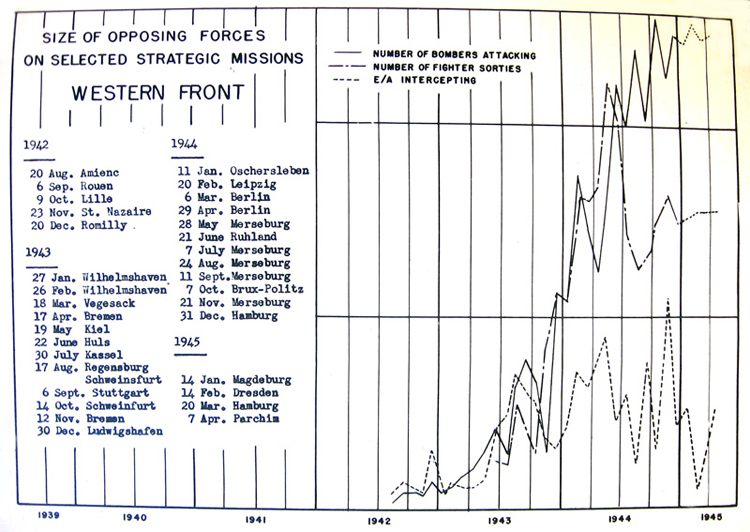
Size of opposing forces on selected strategic missions
n. June 1944. On 6 Tune the Allies landed on the Normandy beaches. The final phase of air preparation had started on 17 April with the bombing of enemy airfields over a wide area to rid the battle zone of enemy aircraft. By the day of the assault, the GAF had been forced to deploy to airfields beyond the cleared zone. The constant bombing had caused GAF tactical units to disperse aircraft in woods and hiding places well away from airfields. Such withdrawals required considerable distances of flight to reach the scene of action, and the widespread dispersal at individual airfields cost much in time and labor to reach a state of "readiness." Both of these factors reduced enemy air efficiency. Enemy capacity, expressed in numbers of sorties flown, was greatly reduced. The Allied air tactics during the landing and the consolidation of the beachhead were to fly continuous patrols by fighters of the Strategic Air Force along the perimeter of the area cleared of enemy fighters. The patrols could watch occupied airfields just beyond this area, attacking at any sign of an attempt to bring aircraft out of dispersals. Within these protective patrols the tactical air forces ranged, watching for any enemy fighters which might elude the outer patrols. These tactics were highly effective. Regarding the invasion, General Fieldmarschal Hugo von Sperrle spoke as follows: "At the time of the invasion, fewer than 500 operational planes were available to meet it; Allied attacks against airfields in the few days preceding D-Day made the use of these planes for the most part Impossible; as a result, we could offer no resistance" (Reference Note 5). From D-Day to the end of the war, the OAF never constituted more than a harassing threat to our surface operations.
o. July 1944. The GAF, already no match for the escort fighters of the Eighth AT, now found itself split between strategic defense and tactical requirements. To the overpowering force of Allied strategic escort was added an even larger fores of Allied tactical fighters. Where there had been a sharp increase in enemy fighter losses in the first half of the year, the loss rate now became catastrophic. With oil production In Germany under attack, the problem of the GAF was critical. In a desperate attempt to throw into the air a maximum defensive force, schools were closed and instructors used as fighter pilots. Short courses were given to convert bomber and transport pilots into fighters. Whole Allied missions would be unopposed in the enemy's attempts to gather strength. The enemy situation is confirmed in an interview with Lieutenant General Karl Koller, Chief of Staff of the Luftwaffe, who stated that In addition to the lack of suitable fighter aircraft, the Luftwaffe was handicapped by lack of petroleum and of well-trained pilots. When General Seller became Chief of the Air Staff in 1943 he found that the total aviation gasoline alloted to pilot training was 10,000 tone a month. By February 1944, he had increased this allotment to 50,000 tons. Thereafter, the progressive difficulties in production caused by air attack made it necessary to curtail training and finally to cease training altogether. (Reference Note 6)
6. US Fighter Control with MEW. A development of importance to American fighter tactics was fighter control by radar. A method of controlling fighters had long been in use whereby friendly fighters could be placed in an advantageous position to attack enemy fighters by directions radioed from ground controllers. The ground control station used radar devices (called Vertical Elevation Beam and Plan Position Indicator) which permitted the controllers to see, upon a fluorescent map, the location of both the friendly and the enemy fighters, and to know the relative altitude of each. Knowing the Position of the sun with reference to the fighters shown on the fluorescent map, the individual controller was able to direct the fighter squadron or group under his control into an advantageous position to attack the enemy fighters. The surprise and advantage of position thus gained resulted In victories of importance for Allied fighters.
7. The British developed this method of fighter control and had carried it to a considerable degree of perfection before the US forces took it up, but the disadvantage of the British system was its limited range. The American contribution was in the form of new devices of considerably extended range and greater accuracy. This equipment was used with a form of control called the Micro-Wave Early Warning System (MEW), integrating into the system information of enemy operations gained by "Y" service (radio interception of enemy controllers' orders to their fighters and enemy inter-aircraft radio conversations). MEW control provided US fighters with knowledge of the exact location of enemy fighters which was of great tactical significance.
8. GAF Fighter Tactics. Prior to the spring of 1944, the GAF had committed its fighters to intercept when and where they could. In 1942, interceptions were made by individual alrcraft, apparently attacking and leaving the fight at will. Early in 1943, head-on attacks were pressed to take advantage of the weakness of firepower in the nose of US bombers. As this armament deficiency was corrected, enemy fighters reverted to attacks from all angles and all levels, continuing, however, to piecemeal their attacks.
9. During the late winter and spring of 1943, experiments wars made with multiple attacks, from two to SO single-engine fighters in line astern attacking the bomber formations. Twin-engine night fighters Joined the day fighters, attempting to bring their heavier fire power to bear on the bomber formations. Air to air bombing was tried, as well as high-angle, large calibre cannon (Reference Note 7),
10. By the summer of 1943, twin-engine fighters were equipped with multiple rocket projectors of large calibre, firing time-fuzed rockets. Some single-engine fighters carried similar armament. The rocket-firing twins were found to be highly lethal to bombers when their rockets were fired in salvo from a formation position astern of the bomber formation (Figure 5). All these attacks were planned for execution beyond Allied escort range since these aircraft were no match for our fighters. Their success In the fall of 1943 then appeared to be the answer to Allied bomber formations. On the vital penetrations to targets deep In Germany, US superiority in the air In daylight was put in serious doubt.
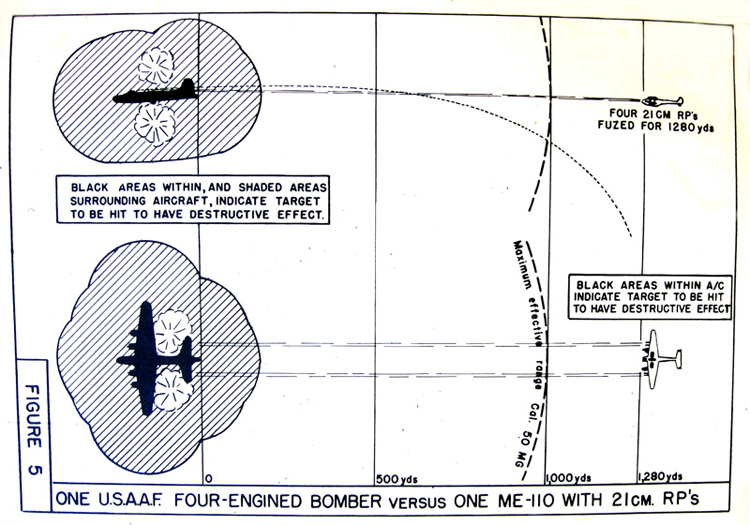
One USAAF four-engined bomber versus one Me-110 with 21cm. RP's
11. The arrival of the Allied long-range escort was in turn the answer to the rocket firing fighters whose positioning for attack astern left them highly vulnerable. Confused by our new fighter capability and the costly losses of twin-engine rocket planes, the High Command returned to single-engine fighter attacks, ordering a concentration on the bombers, combat with Allied fighters to be avoided if possible. This meant the GAF fighter was on the defensive with respect to Allied fighters. The order was a blunder of the first magnitude.
12. Oberst Kogler, commanding officer of Fighter Wing 6 at the time of hi capture in the summer of 1944, stated (Reference Note 8):
"Orders were given to leave Allied fighters alone and concentrate on the bombers. This command led to a vicious spiral of disaster. The GAF concentrated on bombers and were shot down by Allied figthers. The (US) fighters learned that they were safe against attack and became bolder and more effective. The GAF headed for bomber formations which supposedly were not escorted, but you ran into fighters anyway and in the end they were all over the place. The GAF developed an inferiority complex which got worse each day but the High Command would not relax the order."
13. In February and March 1944, squadrons of ten aircraft and groups of 30 were committed as units, attacks being made along most of the bomber route, both penetrations and withdrawals. In the spring of 1944, for the first time, the GAF attempted to concentrate its fighter force into larger formations to obtain local superiority over the US force at a selected point of attack. Some enemy units were highly skillful in the execution of massed wave attacks. But their value largely was against bombers while not under escort and such bomber formations rarely were a major part of the total US forces. Enemy units, on the whole, were too unskilled to accomplish the mass attack. Their formations were haphazard and easily turned. The new tactics did not succeed.
14. Enemy tactics with rocket and Jet propelled aircraft were not fully developed. The rocket plane appeared briefly and was discarded after futile and disastrous commitment. However, the jet
Me-262, armed with four 30-mm cannon and much faster than orthodox fighters, had real possibilities. Its maximum speed of 550 mph at 30,000 feet altitude was about 100 mph faster than the P-51. The
heavy armament was deadly to bombers and the speed made evasion of fighters fairly easy. But by the winter of 1944-1945, when the Jet began to be seen in small numbers, US fighters swarmed the air. The jets accounted for a few bomber kills, but their losses were at least in proportion to their kills. It is still not clear why more jet fighters were not used against the US air forces. Mr Seiler, Chairman of the board of the Messerschmitt Company could never understand why the Me-262 was not used to a greater extent by the Luftwaffe. Late in 1944, at a time when the company had delivered over 650 machines, the Luftwaffe had only 40 operational in combat. He thought that perhaps 250 were non-operational for lack of proper servicing and that failure to provide an adequate pilot training program might be a contributing cause. Nevertheless, he could not understand the discrepancy between production figures and Luftwaffe strength. When Saur demanded that there was no sense in such a demand at a time when the workers were asking, "Where are our machines?" (Reference Note 9).
15. Statistical Comparisons. Combat statistics and comparisons, serve to clarify the trends leading to Allied victory in the air war. Figure 6 entitled "Effectiveness of Enemy Fighters" shows the Increasing lethal capability of the individual enemy fighter. The increase in its fire power from 1942 into 1944 is reflected in the number of bombers lost to enemy aircraft which rose from 2.3 bombers destroyed in each 100 combats with enemy aircraft in 1942, to 17.7 bombers destroyed in each 100 combats with the enemy in mid-1944. This greatly increased fire power had been much more than offset, however, by the tremendous growth of the US force, both in bombers and fighters. For, where 18.2 per cent of US bombers attacking were struck by enemy aircraft fire in mid-1943, only 6.4 per cent were hit in the last quarter of 1943 and the number hit fell below one per cent in the middle of 1944. This chart indicates that the GAF had ceased to be effective against the heavy bombers well before D-Day on 6 June 1944.
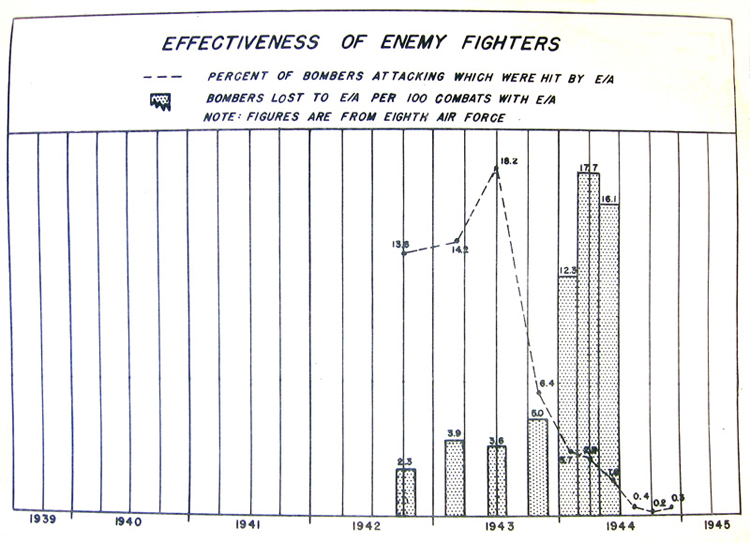
Effectiveness of enemy fighters
16. Another view of the relative effectiveness of the GAF and the AAF is shown by the chart entitled "Loss Rates" (Figure 7). Here are shown yearly average monthly loss rates as a percent of the effective strength of OAF single-engine fighters, Eighth AF combers, and Eighth AF fighters. It will be note that the percentage loss for the bombers rose more rapidly from 1942 to 1943 than did the loss rate for enemy fighters In the same period. This was due to two factors: penetrations were being made by the bombers in that period well beyond the range of their escort; and the rapidly Increasing armament of enemy fighters, particularly the rocket projectors. But the situation reversed with the advent of US long-range escort. Enemy fighter losses increased on a rapidly rising scale, while US bomber losses subsided with equal rapidity. This, was not accomplished without cost to the US forces, whose fighter losses rose sharply from 1943 to early 1944. This increase was inherent in the changed employment from short-range escort in 1943 to the long-range escort in 1944, when the fighters roamed over Germany. That these fighter losses paid dividends is corroborated by Reichsmarshall Goering, who said: "I most firmly believe that the reason for the failure of the Luftwaffe against the Allied air forces was the success of the American Air Force in putting out a long-range escort fighter airplane, which enabled the bombers to penetrate deep into the Reich territory and still have a constant and strong fighter cover. Without this escort, the air offensive would never have succeeded. Nobody thought such long-range fighter escort was possible." (Reference Note 10)
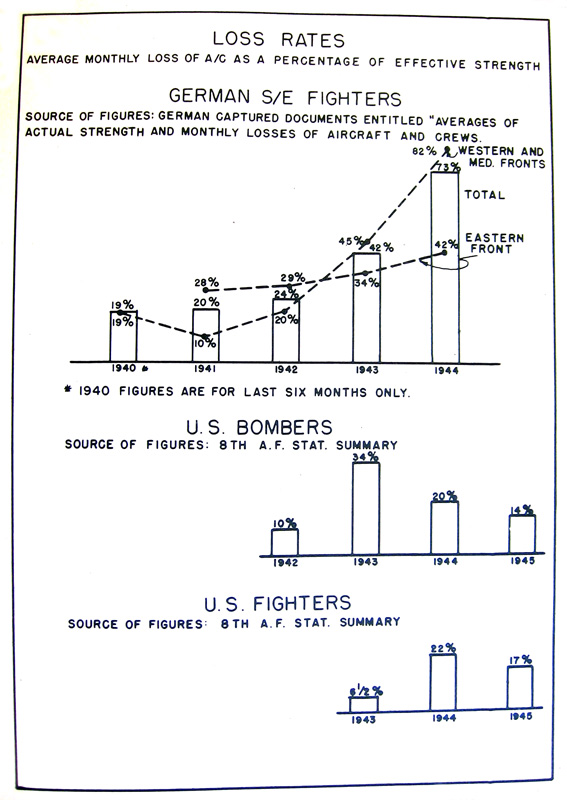
Loss rates
17. The relationship of the quality of the opposing fighter forces as evidenced by their training is brought out in Figures 8 and 9. Figure 8 is a comparison of total training hours of the fighter pilots of the three air forces, the GAF, RAF and AAF. It will be seen that GAF pilots received progressively less training throughout the war 1944 total training hours being roughly half the number given prior to mid-1942. New AAF pilots, on the other hand, received more and more training as the war progressed, the number of hours in 1944 being roughly four times the number of training hours given the German cadet. The RAF pilot received more hours of training than the German in all years after 1942.
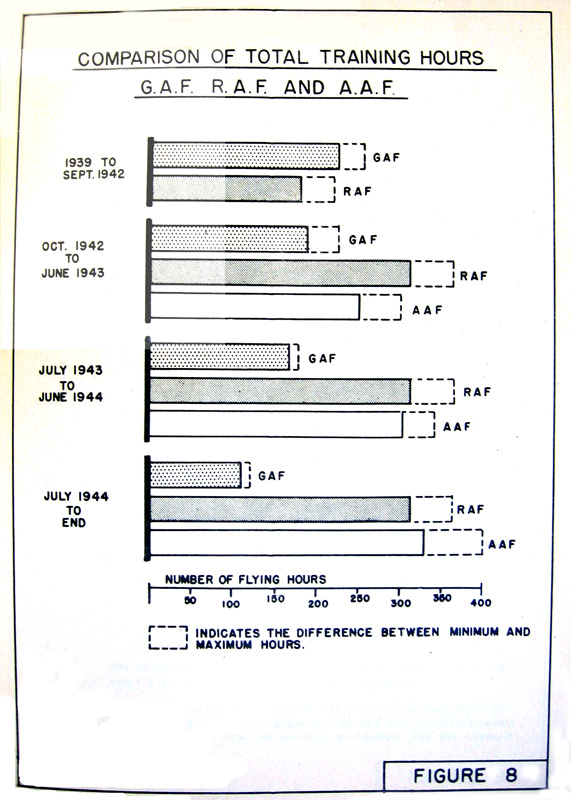
Comparison of total training hours GAF RAF and AAF
18. A comparison of training hours on operational types of aircraft is even more significant (Figure 9). German training of this type dropped to about 40 per cent of the early figure, while US training doubled. A comparison in 1944 shows an average of some 165 hours on combat types for Americans but only 30 odd hours for Germane.
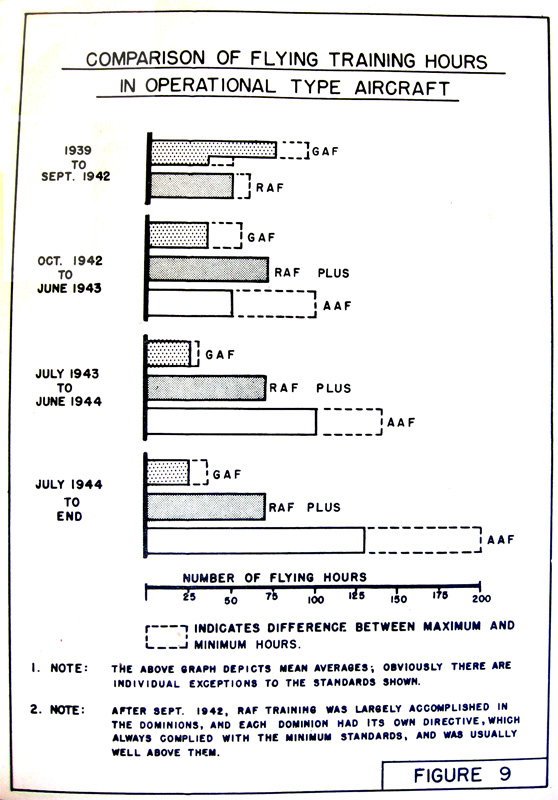
Comparison of flying training hours in operational type aicraft
19. Figure 10 compares the fire power of GAF and AAF fighter-type aircraft. Fire power, as shown herein, is a combination of the number of guns, their calibre, the destructive effect of a hit and the rate of fire. It will be seen that the Me-109 approximated the range of fire power of the American P-47s and P-51s. The Focke-Wulf 190, however, was armed for two different purposes: some of them were very heavily armed for the purpose of destroying bombers, the weight of guns and ammunition being too great a handicap to permit their use in dog fights; others, however, were armed so as to be Just a little more destructive than the heaviest US fighter fire power. So the high-performance Me-109 was intended and used as top cover for the FW-190, which was to destroy the bombers (Figures 11, 12, and 13). The armament of enemy fighters undoubtedly was adequate for their intended purposes.
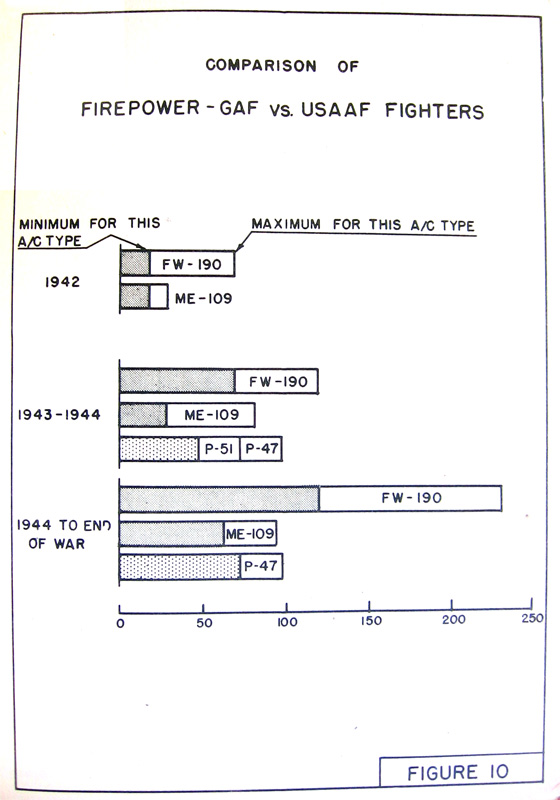
Comparison of firepower - GAF vs. USAAF fighters
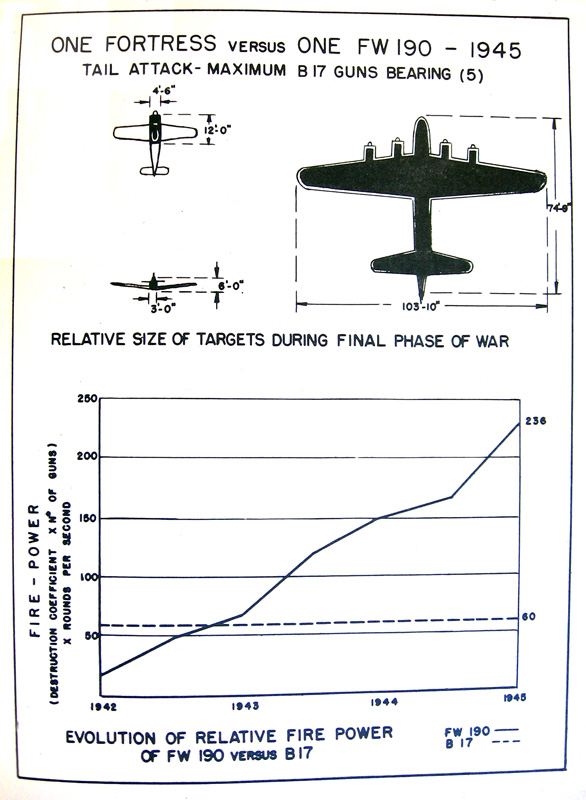
One Fortress versus one FW190 - 1945
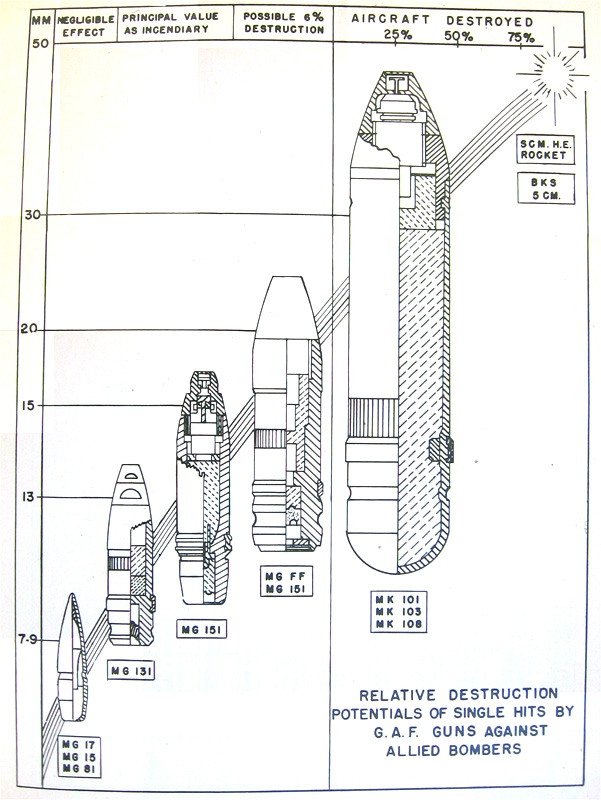
[[Relative destruction potentials of single hits by GAF guns against allied bombers
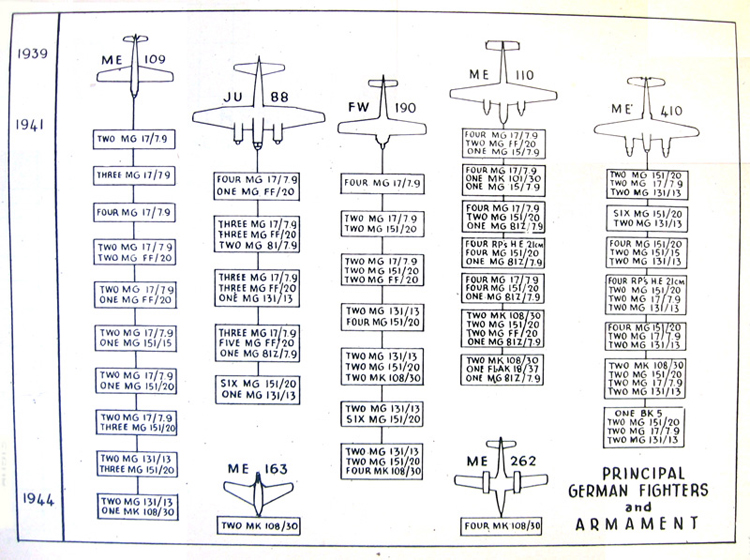
Principal German fighters and armanent
20. The net result of enemy training, armament, size of force and tactics, when, applied to the battle against the superior pilots of the rapidly growing OS Eighth AF can be seen in Figures 14 and 15 which show the trends in numbers of enemy aircraft intercepting Eighth AF missions, numbers of bombers destroyed by enemy aircraft, and the per cent of Eighth AF bombers destroyed by enemy aircraft. The number of enemy aircraft intercepting (Figure 15) rose sharply until the end of 1943, reached a peak In the first half of 1944, and dwindled slowly thereafter. The number of bombers destroyed by these enemy forces rose more rapidly than did the number of enemy aircraft intercepting until the last quarter of 1943. This was the result of heavily increased armament of enemy fighters being brought to bear upon bombers beyond the range of their escort. With the advent of American long-range fighters in the last quarter of 1943, the rise in number of enemy aircraft intercepting did not produce an equivalent rise in the number of Allied bombers destroyed. The few long-range escort fighters employed were paying high dividends In breaking the attacks of the enemy fighters. While the force of US long-range fighters was growing rapidly in 1944, the number of bombers destroyed by enemy aircraft rapidly declined; in fact, much more rapidly than the decline in the number of enemy aircraft attacking. By the end of 1944, the number of bombers destroyed had dropped to one-third of the peak figure.
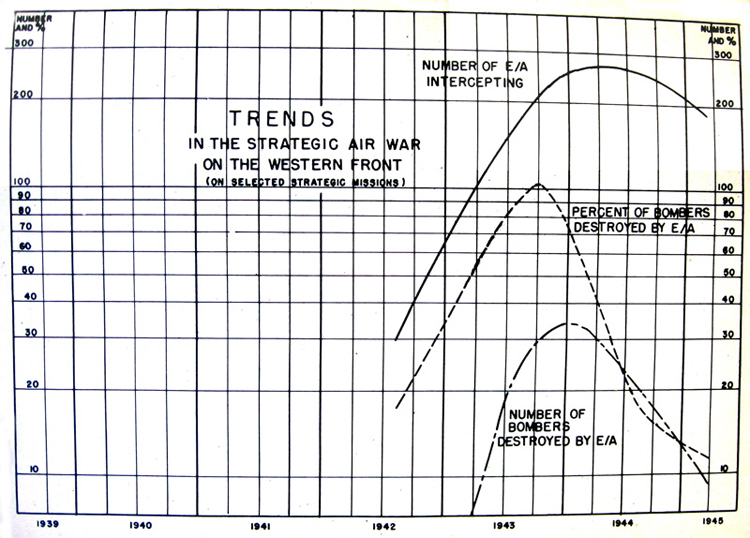
Trends in the strategic air war on the Western front
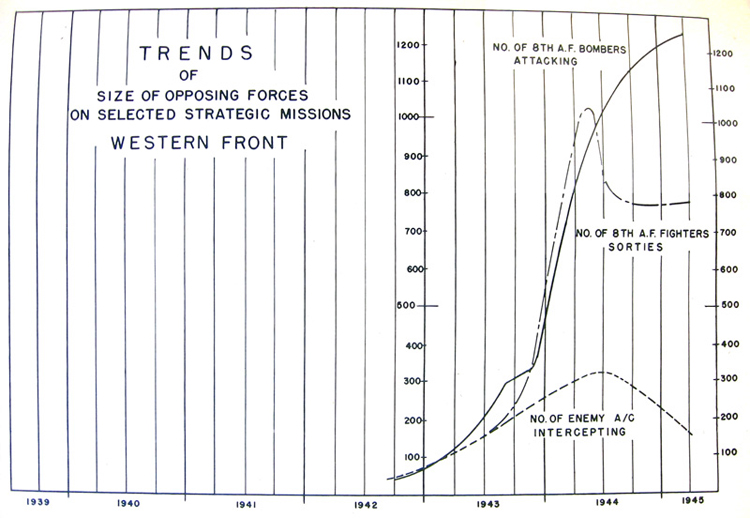
Trends of size of opposing forces on selected strategic missions
21. But numbers tell only half the story. During the last quarter of 1943 and thereafter, through March of 1944, the number of US bombers expanded very greatly. Bombers lost to enemy aircraft as a percentage of the bomber force attacking, fell sharply as the bomber force grew. The GAF, on the other hand, unable to expand materially its fighter force, suffered losses more than twice the total of 1943 and In much greater percentage of strength in front line units (Figure 16). Stated otherwise, the growth in the size of the bomber force was 80 much greater than the growth in the enemy fighter force that German fighter defenses were saturated with attacking bombers. There were far too many bombers exposed as targets to the enemy fighters for the GA? to maintain its proportionate attack. And when long-range escort fighters greatly diminished bomber exposure, GAF fighter efficiency dropped to a minimum.
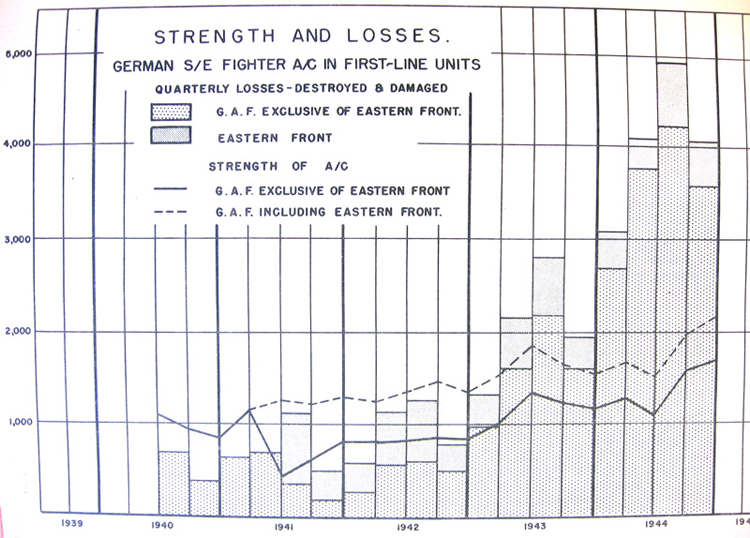
Strength and losses. German S/E fighter A/C in first-line units
THE DELAY IN THE GROWTH 0F THE GAF FIGHTER FORCE
1. Through the early years of the war, 1940 until mid-1942, the GAF underwent very little expansion. The easy victories in Poland and France had convinced the High Command that the OAF was adequate for any task. Production priorities for the GAF fell behind tanks and U-boats, lieutenant General Werner Kreipe of the General Staff of the Wehrmacht and Director of the Luftkriegs Akadamie confirms this in stating that from 1941 on aircraft had a lower production priority than tanks and U-boats because Goering had relatively little influence on Hitler in this natter and, in any event, Goering, along with most of the General Staff, had been carried away by the ease of victory in France, Poland, and the Balkans. General Kreipe stated he could never understand why it was that the General Staff of the Wehrmacht never gave due credit for the contribution made by air power to early German victories (Reference Note 11).
2. Not until strategic day bombing by the Eighth AT appeared as a real threat did the OAF begin to show increases in operational strength. In 1943 single-engine fighter defenses on the Western Front were built to nearly double their size at the beginning of the year (Figure 17). This 40 per cent jump in strength on the Western Front was not the result of an overall rise in GAF fighter strength, for the total fighter force on all fronts rose less than 20 per cent.
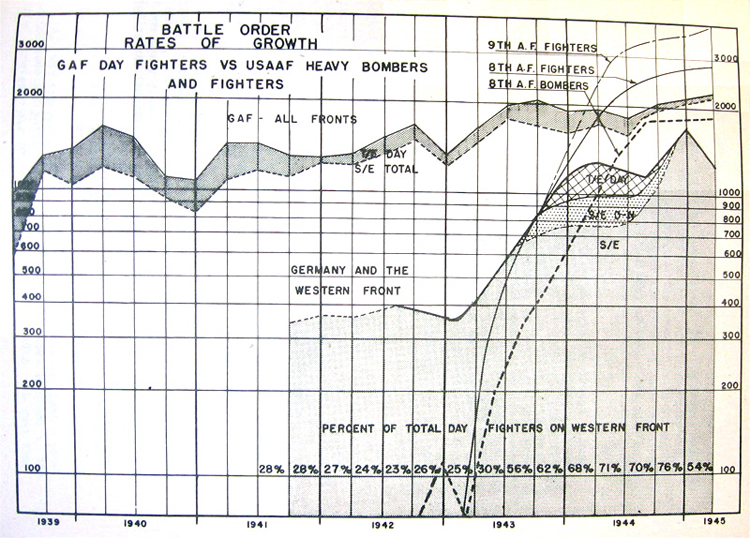
Battle order rates of drowth. GAF day fighters vs USAAF heavy bombers and fighters
The rise on the Western Front was accomplished by withdrawing same 180 single-engine fighters from the Eastern Front during the year and an additional 120 from the Mediterranean. The total rise in strength on the Western Front during 1943 was of the order of some 380 single-engine fighters. Hence, nearly 80 per cent of this total rise In the west came about through robbing the Eastern and Mediterranean Fronts of fighter aircraft.
3. This redeployment constitutes a remarkable paradox in that the German High Command, long believer in ground cooperation as the correct use of air power, ware robbing their two ground fronts of aircraft for defense against air invasion from the west. In the east, the German Sixth Army had been trapped west of Stalingrad and surrendered in February 1943; the Wehrmacht had been forced out of the Caucasus when Virtually within sight of the oil regions which had been its goal; in July, a do-or-die offensive was launched by .the Germans toward Kursk and Orel, resulting in defeat and terrible losses; during the last half of 1943, the Wehrmacht was in full retreat across Russia.
4. In the Mediterranean, meanwhile, the Afrika Korps had been compressed between Allied armies advancing from the east and from the west; the German surrender came in Tunis in May; Sicily was Invaded and cleared by the Allies in August; Italy itself was invaded and knocked out of the war in September. Clearly, these events made the time inauspicious for the- removal of large numbers of German fighter aircraft from the Russian and Mediterranean Fronts. The moves were made because of a greater danger threatening from the west. The growing strategic air forces were striking at the vitals of Germany herself. The growth of the US heavy bomber force In England was feared by the Germans and every effort was made to build up fighter defenses for Germany, regardless of the cost on the ground fronts. Battles in Africa and beyond the Ukraine seemed far away compared to actual bombing at Bremen, Kassel, Schweinfurt, Stuttgart and Regansburg (Figure 18).
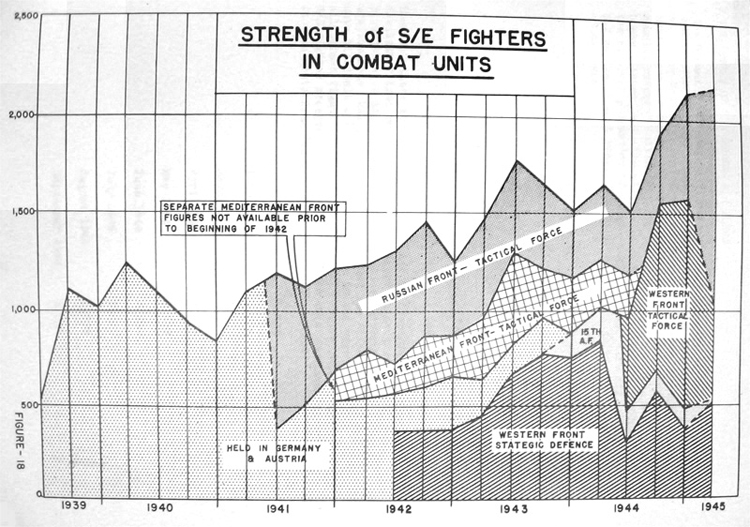
Strength of S/E fighters in combat units
5. The increased GAF deployment on the Western Front was accompanied by a strenuous effort to increase fighter production. The OAF planners, led by Field Marshal Milch, obtained approval late in 1943 of emergency plans for rapid expansion of the fighter force. The GAF studies and industry programs approved in August and October of 1943 sat a goal for production of 3,800 aircraft per month by September 1944. This-figure takes on significance when compared "with acceptances of 853 single-engine fighters in September 1943 (Reference Note 12).
6. The tremendous German effort for expansion of fighter production received particular impetus from the attacks launched by the Allied strategic air forces in the last half of 1943. At that time the airman single-engine fighter aircraft industry depended almost entirely on all huge plants for final assembly. Me-109s were assambled at Wlener-Neustadt, Regensburg and Leipzig; FW-1O9s at Oschersleben, Marienburg and Tutow. These aircraft assembly plants received hlgh bombing priority (ultlmately top priority) and a mounting weight of bombs (Figure 19).
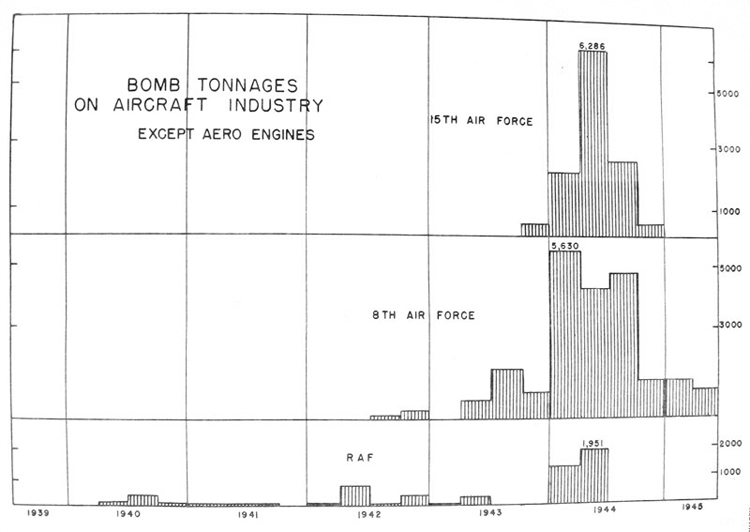
Bomb tonnages on aircraft industry
The attacks in 1943 were successful, judging by the reported production or single-engine fighter aircraft in the last six months of that year. The Speer Ministry figures show acceptances as follows:
July 1943 1.050
August 1943 914
September 1943 853
October 1943 966
November 1943 770
Decamber 1943 360
However, these attacks forced the enemy to disperse his production facilities into many new plants above and below ground. Highest priorities In labor and materials and close government-industry cooperation made this possible. Thus by 1944 the Allied bombers had a more difficult target system and, later in the year, could not reach all German fighter production facilities. The reported figures for S/E fighter acceptances by the GAF in 1944 show continued increases in each month from February to a peak in September.
January 1944 1,316
February 1944 1,016
March 1944 1,377
April 1944 1,696
May 1944 1,907
Juno 1944 2,177
July 1944 2,687
August 1944 2,779
September 1944 3,031
October 1944 2,735
November 1944 2,776
December 1944 2,424
Production figures would show a different picture from acceptances month to month; but the trend is unmistakable. The German economy had gone all out to produce fighter aircraft and not without some success. In the face of increasing attacks, a force of over 300 000 laborers was assigned to repair and restore damaged plants. The recoveries were remarkable.
7. The reported production, however, did not satisfy GAF requirements and the programs of the aircraft Industry were not met in any month. Toe Allied attacks were effecting damage which, though hastily repaired, caused the Industry to fall short of GAF requirements. Delay In reaching the necessary level of production, at a time when delay meant inadequacy of force, was fatal. Aircraft required to maintain a rate of growth for the GAF commensurate with the Allied rate were needed in the beginning of 1944, not at the end of the year. Actually, Allied strength was outdistancing the GAF in the late months of 1943. The Chart (Figure 15) indicates the inability of the GAF to match forces with the Eighth AF alone. When faced as well with the 1,300 bombers and 400 fighters of the Fifteenth AF operating from Italy, the numerical Inferiority of GAF fighters became even more apparent.
8. Comparison of the production plan approved on 1 October 1943 with the actual acceptances achieved in 1944 reveals that fighter aircraft acceptances in 1944 fell short of plans by some 13,000 aircraft. This plan of 1 October 1943 was stated by Field Marshal Milch to meet the requirements for GAF fighter strength in 1944. Comparison of acceptances with this plan is the more appropriate for this reason (Reference Note 12).
9. The importance attached to fighter production is attested by the fact that in February 1944 Speer prevailed upon Hitler to reassign the responsibility for fighter production from the Air Ministry (Goerlng; to the Ministry for War Production (Speer). The Air Ministry was consulted only for a statement of GAF requirements. These were contained in "studies" which appeared in increasing numbers after August 1943. Such succeeding study recognized that production had not risen" expected and called for more rapidly increasing production in the future months. These studies, when approved by the industry and the Speer Ministry, became industrial programs. The new studies and programs make it possible to check the delays suffered in obtaining desired production. When a new study was approved in December calling for production that was expected in September on the previous plan, a three months' delay in planned production was acknowledged.
10. Figure 20 illustrates the principle involved. Assume that a plan of production shows a certain increase in production rates from one month to the next, rising from 500 per month at the start to 1,000 per month half a year later. Now, if another plan is made at the end of the half-year, also starting at the rate of 500 per month, it is apparent that the "expectation" of the planners has been disappointed and that the increase to 1,000 aircraft per month in rate of production expected has not been achieved. This would constitute a six months* delay In "expectation" for increased production
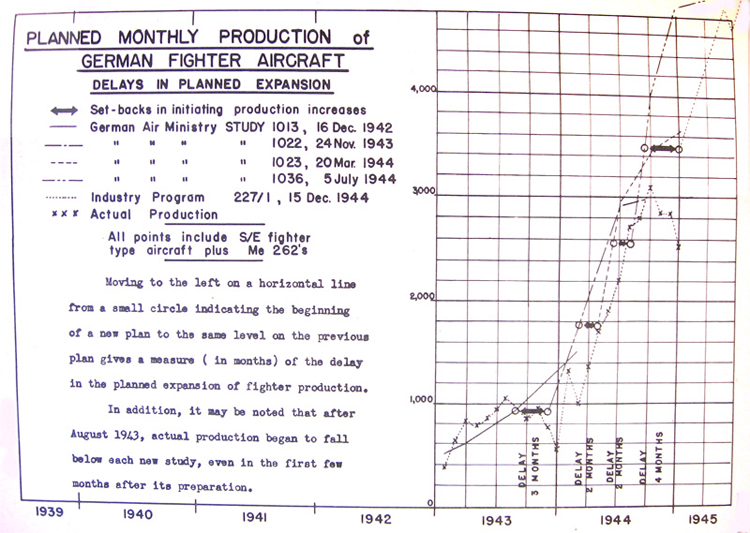
Planned monthly production of German fighter aircraft
11. Tne "expectation" at the beginning of a plan should be closely approximate to the facts of production. Wherever actual production falls below the rate of production called for at the beginning of a plan, It is apparent that the industry has suffered a delay which is in the nature of a catastrophe to the planners. For, if a rate of production for next month cannot be calculated With any accuracy, what good is a plan of production for next year?
12. On the chart (Figure 20) horizontal lines are drawn from the production curve of one plan to the starting point of the following plan. These lines show the time lost between plans; the new plan is starting at a rate which should have been reached some time before, as shown on the earlier plan. Going from the starting point of a new plan vertically upward to the previous plan shows the difference between the present expected rate of production and what had been expected for the same data when the earlier plan was made. The chart brings out four major set-backs in "expectation."
13. So far the emphasis has been on plans. On the same chart, crosses are placed to Indicate officially reported rates of actual acceptance of aircraft. It will be noted that these crosses fall below the curves showing planned rates of production all through 1944, generally from two to three months behind the plan. Turning to Figure 19, it is seen on the chart of bomb tonnages dropped on aircraft and component parts factories that the periods of heavy bombing coincide with the periods when production dropped below plans.
14. There can be no exact assessment of the number of fighter planes "lost" to the OAF as a result of Allied attacks on production. Neither can we assess accurately the disposition of the fighter aircraft which. the Speer Ministry reported to Hitler as newly accepted aircraft. The claimed production of some 36,000 single-engine fighter aircraft in the year 1944 greatly exceeds the number of aircraft which can be accounted for in Luftwaffe units and by records of losses.
15. Hitler was known to demand miracles from his subordinates. Many were replaced if they did not live up to his demands. Under these circumstances, it is not entirely impossible that Messrs Speer and Saur, controlling aircraft production, "rigged" their accounting to make a satisfactory showing. Dr Wagenfuehr, Speer's statistical chief, referred to the "mystery" of these great numbers of aircraft claimed produced but not appearing in the battle line.
16. The mystery of "where were all the aircraft going which were claimed to be produced?" requires examination. Obviously, if 3,000 fighter aircraft are produced in a month and aircraft destroyed in that month are only 1,000 the 2,000 excess of production over losses should appear in the battle order of the GAF, less a few for training schools, second-line units, etc. Turning to Figure 21, it will be noted that the GAF fighter battle order on all fronts increased in 1944 only from 1,500 to some 2,200, while 3/E fighter "production" exceeded losses in first line units in the same period by more than 16,000. At the same time, fighter school commanders were complaining that there was a serious shortage of operational types of aircraft on which to train. Oberst Littman, commanding offlcer of Straubing Airport flying school, stated that he was told lies about the number of aircraft in the Luftwaffe. His training school had bean short of gasoline and operational type aircraft since the summer of 1943. Flying school commanders had periodical conferences, and he thereby knew that this condition prevailed throughout the training command (Reference Note 13).
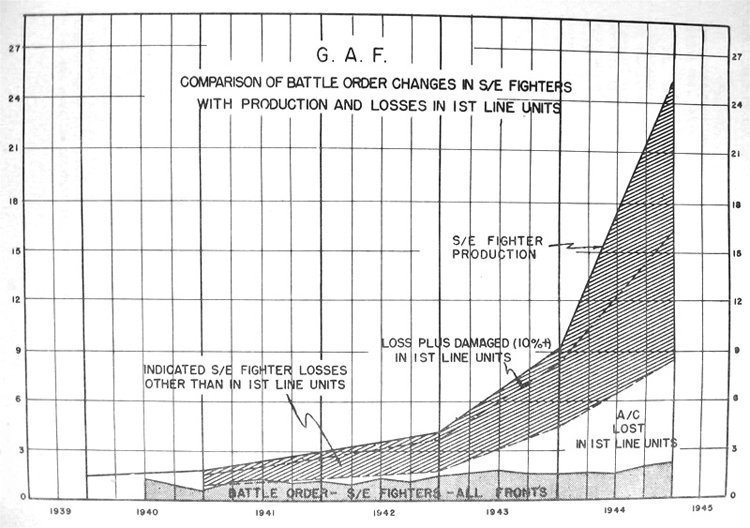
GAF comparison of battle order changes in S/E fighters with production and losses in 1st line units
17. Even if all fighters damaged more than 10 per cent are added to lost aircraft, more than 8,000 fighter aircraft remain to be accounted for. This means that, if all aircraft receiving anything more than superficial damage were scrapped, there would still be over 8,000 which disappeared.
18. The conclusion - or perhaps "suspicion" is the better word - is that nowhere near so many aircraft were produced. A clue to the mystery may be found in the reports of interrogation of Dr Wagenfuehr (Reference Note 14) where he states, speaking of 1944 (February, March): "this great increase of fighter production was partially made possible by the fact that Saur made use of all the available stocks in the supply and component industries. This boosting of production was not made on a sound foundation; it was single 'shock-production.' "
Later, in the same report, he states: "Further sources of error are to be found In the way aircraft under repair were accounted for. There were three possibilities of repair which had to be considered:
"a. Repair with the troops (not counted in the statistics).
"b. Repair requiring up to 1,000 man-hours, which went to the repair shops. At first, these repairs were counted as stocks. After the crucial period In i.943, they were no longer considered In the statistics.
"c. The normal case: 'Extensive repairs,' which meant that the planes went back to the manufacturers and were counted both as losses and, later, (when they cams back) as new production."
19. Unquestionably there exists, in German aircraft statistics a discrepancy between claimed new production when compared to losses and the strength in units of the GAF. Production of all operational types of aircraft in 1944 was claimed at some 39,000 (Figure 22). Strength in units at the end of 1944 was virtually unchanged from the beginning of the year. With aircraft written off in 1944 totaling 21,946, there remains unaccounted for a difference of some 17,000 planes; ie, the excess of claimed production over aircraft written off. It is unreasonable to believe that 17,000 planes were destroyed outside of units. A possible partial answer is furnished in the statistics which show 5,689 more aircraft going into repair than were returned for allocation to units. Part of these may well have been repaired, marked as "new production" aircraft and entered in the accounting system as such. In addition, the statistics show that 25 to 30 per cent of the so-called new production aircraft was allocated to "sundry and modification" instead of to GAF units. The records snow the assignment of a negligible number of aircraft from modification to GAF units. There is a strong supposition that aircraft came out of modification again marked as new production (Reference Notes 15 and 16).
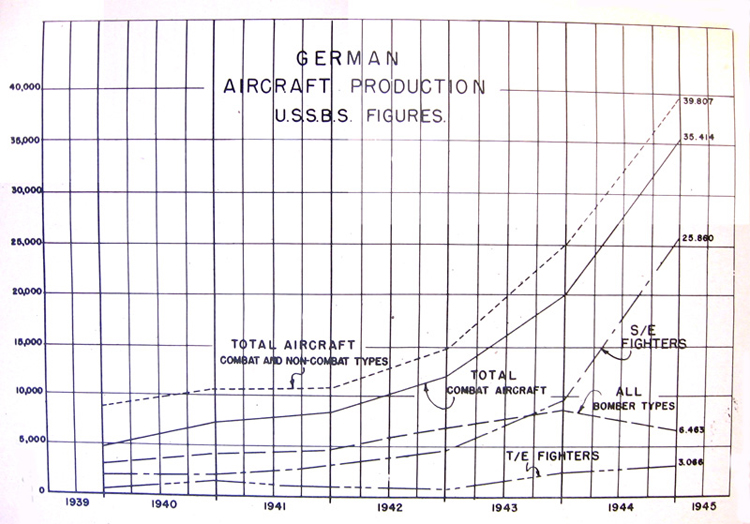
German aircraft production
DESTRUCTION OF THE SOURCES OF ENEMY AIRCRAFT FUEL PRODUCTION
1. In May 1944 the Allied air forces reached a new high level in operational bombardment sorties. Those missions which were not required In direct preparation for the ground invasion were aimed primarily at installations producing oil and aviation gasoline. From England the Eighth AF by day, and, subsequently, the RAF by night carried heavy destruction to these facilities against the strongest flak and smoke defenses ever mounted by the GAF. The Fifteenth AF from Italy delivered
simultaneous blows against oil and gasoline production in southern Germany, Silesia, Austria and Roumania. Results were devastating. The Germans worked feverishly to restore damaged plants, but their efforts were frustrated by return missions timed to prevent a major resumption
of production.
2. Raids against oil and gasoline production were continued through the fall and -winter of 1944 with outstanding success (See the Oil Industry Report of the USSBS). German oil reserves were rapidly consumed and by the year's end the situation was desperate. Figure 23, showing production and imports of aviation gasoline, consumption and the decline of reserves, brings this out vividly. As early as June 1944, Production Minister Speer indicated to Hitler hi8 grave concern over th« attacks on oil and gasoline production. He recognized that destruction of fuel production would lead to defeat for the German war machine and recommended an all-out effort to ward off these attacks. Lieutenant General Karl Kollar, Chief of Staff of the Luftwaffe, gave the following facts relative to oil: "Oil was an excellent target system. The Luftwaffe was using 198,000 tons of aviation gasoline per month in the sunnier of 1943 and later plans called for an increase in this production to 320,000 tons per month... By the spring of 1945, as a result of air attack the Luftwaffe only obtained 6,000 tons per month" (Reference Note 17).
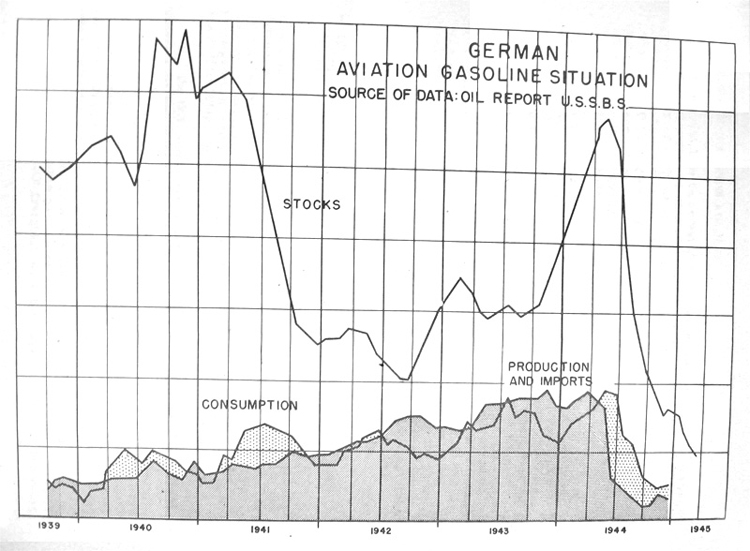
German aviation gasoline situation
3. From the start of the attacks against fuel production In May 1944, German output declined. The diminishing supply of aviation gasoline resulted at once in serious operational limitations. Training hours, already drastically limited because of fuel shortages, were cut to the bone. Instructors and transport and bomber pilots were given short conversion courses in a last-ditch effort to increase the fighter defenses against the Allied air armada (Reference Note 1). Pressure was brought to conserve fuel even on operational flights. Motor transport, essential for GAF repair and supply was reduced nearly to the vanishing point. Thus the attack on oil, made possible through the attainment of air supremacy, was a prime factor in assuring the permanence of that superiority. The GAF, which had once threatened the ability of the RAJ to continue night bombing attacks, was so completely demoralized that the early months of 1945 saw the RAF carrying out daylight bombing operations in great force with a minimum loss.
DISRUPTION OF THE GAF SUPPLY AND REPAIR SYSTEMS CAUSED BY ATTACKS ON GERMAN TRANSPORTATION
1. In September of 1944, the strategic air forces shifted primary attention to transportation targets. Here again the RAF and Eighth and Fifteenth AFs combined to deliver a huge tonnage of bombs. The results are well known. Most German experts attribute the final German downfall to the hopeless eoonomic confusion caused by disruption of the transportation system. Wehrmacht officers as well have testified to the difficulties Imposed on operations as a result of these attacks.
2. The GAF repair system Involved the return of seriously damaged aircraft to the factory which manufactured that type. Rail transportation was largely used to move such aircraft from airdrome to factory.
The factories, under the intensive dispersal program, had been scattered over different sections of German territory and consequently were dependent on the railways for delivery of vital components and parts. So also for local repairs and maintenance the GAF depended on rail transport for spare parts and supplies of all sorts, Including gasoline and ammunition. The heavy attacks on marshaling yards not only delayed train movements f6r considerable periods of time but often resulted in destruction of oars carrying GAF freight. At a time when the GAF was suffering severe losses and damage in the air war, speedy repairs to damaged aircraft were essential. Delays in the repair cycle meant that units depended almost entirely on new production for replacements. It is significant that "new production" which was presumably increased nearly threefold in 1944 did not provide the GAF with sufficient fighter aircraft to augment its order of battle and that at no time in 1944 was the GAF able to compete numerically with the Allied air forces. It is clear that the attacks on transportation contributed in no small measure to the dilemma confronting the OAF.
3. In summary, then, the attacks on oil and transportation launched in mass after air supremacy had been obtained were two vital factors preventing the revival and resurgence of the GAF. The Luftwaffe, whose task it was to ward off attacks on oil and transportation, suffered its death blow in failing to accomplish that task.
REFERENCE NOTES
Ref Note No
1. USSBS, Military Analysis DiTiBion, "OAF Program for Training Day-Fighter Pilots."
2. USSBS, Interview No 32, page 12
3. USSBS, Military Analysis Division, "Relative Performance of British and American Fighters against German Fighters."
4. USSBS, Interview No 8, page 6.
5. USSBS, Interview No 32, page 2.
6. USSBS, Interview No 8, page 7.
7. USSBS, Military Analysis Division, "Armament in the Air War, 1939-1945."
8. Hq AW Intelligence Summary No 45-8, 3O April 1945, page 10.
9. USSBS, Interview No 7, page 2.
10. USSBS, Interview No 56, page 7.
11. USSBS, Interview No 28, page 3,
12. USSBS, Military Analysis Division, "German Air Force - Planning and Requirements in Relation to Production."
13. USSBS, Interview No 80, page 1.
14. USSBS, Interview No 79, page 5.
15. British Air Ministry, ADI(K) Report No. 342/1942.
16. USSBS, Military Analysis Division, "German Air Force - Order of Battle and Losses."
17. USSBS, Interview No. 8, page 7.
